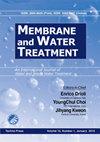Nutrient removal from secondary effluent using filamentous algae in raceway ponds
IF 1.1
4区 工程技术
Q4 ENGINEERING, CHEMICAL
引用次数: 3
Abstract
In this study, we investigated the cultivation possibility using Hydrodictyon reticulatum in a continuous raceway pond as a tertiary sewage treatment plant. The cultivation possibility was evaluated by varying the light quantity, wavelength, and hydraulic retention time (HRT). Experimental results showed that the growth rates of algae and the removal efficiencies of nutrients increased as the light quantity increased, and the maximum photosynthetic rate was maintained at 100 umol/m2.s or higher. When wavelength was varied, nutrient removal efficiency and growth rate increased in the following order: green light, red light, white light, and blue light. The nutrient removal efficiencies and algae productivity in HRT 4 d were better than in HRT 8 d. We conclude that if Hydrodictyon reticulatum is cultivated in a raceway pond and used as a tertiary treatment facility in a sewage treatment plant, nutrients can be effectively removed, and production costs can be reduced.利用丝状藻类去除污水中的营养物质
在本研究中,我们调查了在连续滚道池中使用网状水网藻作为三级污水处理厂的培养可能性。通过改变光量、波长和水力停留时间(HRT)来评估培养的可能性。实验结果表明,随着光照量的增加,藻类的生长速率和营养物质的去除效率增加,最大光合速率保持在100μmol/m2.s或更高。当波长变化时,养分去除效率和生长速率依次增加:绿光、红光、白光和蓝光。HRT 4 d的养分去除效率和藻类生产力优于HRT 8 d。我们得出的结论是,如果在滚道池中培养网状水网藻并将其用作污水处理厂的三级处理设施,则可以有效去除养分,并降低生产成本。
本文章由计算机程序翻译,如有差异,请以英文原文为准。
求助全文
约1分钟内获得全文
求助全文
来源期刊

Membrane Water Treatment
ENGINEERING, CHEMICAL-WATER RESOURCES
CiteScore
1.90
自引率
30.00%
发文量
0
审稿时长
>12 weeks
期刊介绍:
The Membrane and Water Treatment(MWT), An International Journal, aims at opening an access to the valuable source of technical information and providing an excellent publication channel for the global community of researchers in Membrane and Water Treatment related area. Specific emphasis of the journal may include but not limited to; the engineering and scientific aspects of understanding the basic mechanisms and applying membranes for water and waste water treatment, such as transport phenomena, surface characteristics, fouling, scaling, desalination, membrane bioreactors, water reuse, and system optimization.
 求助内容:
求助内容: 应助结果提醒方式:
应助结果提醒方式:


